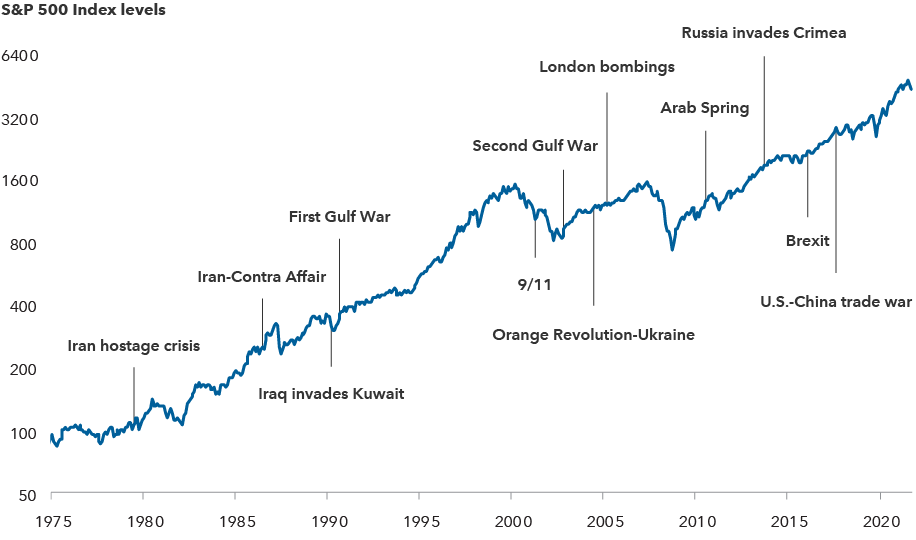Equity markets have historically powered through geopolitical events

Sources: Capital Group, Refinitiv Datastream, Standard & Poor’s. Index levels reflect price returns, and do not include the impact of dividends. Chart shown on logarithmic scale. As of 2/28/22. Standard & Poor’s 500 Composite Index is a market capitalization-weighted index based on the results of approximately 500 widely held common stocks.
It may be easy to feel overwhelmed by news headlines and stock tickers on a daily basis, however, it is important to pause, take a breath, and gain some perspective to the long-term trends that are driving companies and markets. Historically, economic and geopolitical turmoil have not be able to outlast patient, strategic financial planning. In other words, in any market condition, there are always investment opportunities. You just need to know where to look. That is why we have summarized for you a recent article from Capital Group to provide some insights into 7 investment trends for 2022.
- Pricing Power – With inflation hitting record levels, investors should be looking at companies that can sustain their profit margins by passing the increased cost of goods sold along to customers. Certain industries have an easier ability to accomplish this. Pharmaceutical and biotech companies like Pfizer and UnitedHealth will always be in high demand. Business with strong brand recognition, like Keurig Dr Pepper and Coca-Cola, carry less risk of losing customers over increased prices.
- Technology – While many consumers are complaining about supply chain issues, chipmakers like Advanced Micro Devices, Samsung, and ST Microelectronics are benefiting from sky-high demand. Many businesses are turning to cloud technology to power their operations, making semiconductors, legacy software, and software-as-a-service (SaaS) one of the fastest growing industries of the last decade. That does not look to be slowing down any time soon.
- The Return of Dividends – During the pandemic, some companies – particularly in Europe – suspended dividends primarily due to political or regulatory pressure. As a result, many of them have surplus capital to redeploy as regular and catch-up dividends. Don’t be so fast to snatch up the highest yields because research conducted by Capital Group shows that since 2007, the highest yielding quintile of stocks had the lowest overall returns. It is still wise to find companies focused on sustained, earnings-based dividend growth over the long-term because it offers a measure of resilience against inflation and interest rate hikes – two events the United States is currently experiencing.
- Healthcare – Although it’s satisfying to refer to the pandemic in past tense, we are not out of the woods yet, which means innovation in health care remains a top priority. The speed at which Pfizer and Moderna developed and deployed their vaccines is an indication of the strength and commitment to discovering new drugs, therapies, and improved diagnostics. According to the Food and Drug Administration, in the last 5 years the FDA has approved, on average, 75% more novel drugs than in the previous nine years. In addition, as technology improves, remote patient monitoring and home diagnostics are becoming part of the continuum of care.
- Transportation – This sector is moving faster in favor of electric vehicles (EVs), due mostly to government incentives and more strict emissions standards for gas-burning cars. Companies are competing for market share with lower prices, better performance, and longer range. The inclusion of software has given vehicles the ability to learn and improve over time through wireless updates. Most exciting (or unnerving, depending on who you ask) is the advancements in the autonomous vehicle industry. Alphabet’s Waymo operates a fully functional robotaxi service in Arizona open to the public. General Motors’ Cruise intends to launch their fully driverless robotaxi service in San Francisco before the end of this year. Self-driving truck startup TuSimple completed an industry first 80-mile autonomous truck ride on public roads with no human in the cab and zero interventions required.
- Media Disruption – The fast-growing segment of the media sector is gaming. Interactive video game companies like Microsoft and Sony are big reasons why this $200 billion industry has surpassed the movie industry in terms of annual gross revenue. In another segment, Netflix continues to get punished by investors for its massive subscriber loss. In Q1, Netflix loss over 200,000 subscribers – the first quarter they have lost subscribers since 2011. For those hoping for a bounce back, the streaming entertainment company anticipates losing 2 million more subscribers in the 2nd quarter!
- Flexible Fixed Income – As mentioned earlier, inflation can lead to increased profits for companies able to pass the additional cost of goods sold to customers. The economy is doing well because more people have jobs and cash they’ve been sitting on throughout the pandemic. Consumer demand is very high and that bodes well for companies with strong balance sheets and a comprehensive growth plan. That is why corporate bonds may be a worthwhile venture and, more specifically, high yield and securitized debt bonds because of their shorter interest duration and the economy’s overall strength.
Don’t allow short-term events around the world derail your financial plan. Focus on your long-term objectives and speak with your Certified Financial Planner to strengthen your portfolio. Perhaps it will result in following one of these trends of 2022.